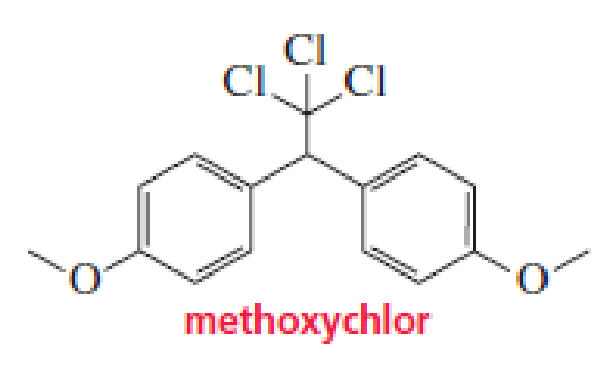
Methoxychlor is an insecticide that was intended to take DDT’s place because it is not as soluble in fatty tissues and is more readily biodegradable. It, too, can accumulate in the environment, however, so its use was also banned—in 2002 in the European Union and in 2003 in the United States. Why is methoxychlor less soluble in fatty tissues than DDT?

Interpretation:
The reason for methoxychlor is less soluble in fatty tissues than DDT has to be given.
Concept Introduction:
Compounds in which one or more hydrogen atoms are replaced by halogen atoms are called alkyl halides.
These alkyl halides usually undergo substitution or addition reactions.
The electronegative atom is replaced by another atoms or group are referred as substitution reactions.
The electronegative atom is eliminated along with a hydrogen from adjacent carbon is called elimination reactions.
Answer to Problem 1P
The methoxychlor can form hydrogen bonds with water. Thus it is less soluble in fatty tissues.
Explanation of Solution
Methoxychlor is a chemical compound. It has methoxy group instead of chlorine on the benzene ring in DDT (dichlorodiphenyltrichloroethane). These methoxy groups can form hydrogen bonds with water. Thus makes it more soluble in water than fatty tissues.
The reason for methoxychlor is less soluble in fatty tissues than DDT was given.
Want to see more full solutions like this?
Chapter 8 Solutions
Essential Organic Chemistry, Global Edition
- Fill in the missing reagents, conditions, intermediates or products in each box below.arrow_forward(A true story.) A drug user responded to an ad placed by a DEA informant in a drug-culture magazine. He later flew fromColorado to Maryland, where he bought some 1-phenyl-2-propanone (P2P) from the informant. The police waited nearlya month for the suspect to synthesize something, then obtained a search warrant, and searched the residence. They foundthe unopened bottle of P2P; apparently, the suspect was not a good chemist and was unable to follow the instructions theinformant gave him. They also found pipes and bongs with residues of marijuana and cocaine, plus a bottle of methylamine hydrochloride, some muriatic acid (dilute HCl), zinc strips, flasks, and other equipment.(a) Assume you are consulting for the police. Show what synthesis the suspect was prepared to carry out, to provideprobable cause for the charge of attempting to manufacture a controlled substance.(b) Assume you are a member of the jury. Would you convict the defendant of attempting to manufacture a…arrow_forward1. What type of TAG is given above?2. How many kinds of products will be formed from the saponification of this TAG?arrow_forward
- Explain this difference in potency and speed of onset by pointing out the main differences in functional groups between morphine and heroin.arrow_forward4. WHAT ARE IMINES? HOW ARE THEY FORMED? 5. WHAT IS GRIGNARD REACTION? WHAT CONSTITUTES A GRIGNARD REAGENT? 6. WHAT IS KETO-ENOL TAUTOMERIZATION?arrow_forwardCan you help with part b. Thank you!arrow_forward
- 1. Why is acetanilide no longer available as a drug in the market? 2. Why is the synthesis of acetanilide still relevant? 3. Can acetanilide be re-offered to market again?arrow_forwardFill in the boxes with the appropriate reagents:arrow_forwardFill in the appropriate reagents for the following reaction:arrow_forward
- A diuretic is a compound that causes increased urination and thereby reduces fluid volume in the body. An important use of diuretics in clinical medicine is in the reduction of the fluid buildup, particularly in the lungs, that is associated with congestive heart failure. It is also used as an antihypertensive (i.e., to reduce blood pressure). Furosemide, an exceptionally potent diuretic, is prescribed under 30 or more trade names, the best known of which is Lasix. The synthesis of furosemide begins with treatment of 2,4-dichlorobenzoic acid with chlorosulfonic acid in a reaction called chlorosulfonation. The product of this reaction is then treated with ammonia followed by heating with furfurylamine. Q. Propose a mechanism for the chlorosulfonation reaction in Step (1).arrow_forwardA diuretic is a compound that causes increased urination and thereby reduces fluid volume in the body. An important use of diuretics in clinical medicine is in the reduction of the fluid buildup, particularly in the lungs, that is associated with congestive heart failure. It is also used as an antihypertensive (i.e., to reduce blood pressure). Furosemide, an exceptionally potent diuretic, is prescribed under 30 or more trade names, the best known of which is Lasix. The synthesis of furosemide begins with treatment of 2,4-dichlorobenzoic acid with chlorosulfonic acid in a reaction called chlorosulfonation. The product of this reaction is then treated with ammonia followed by heating with furfurylamine. Q. Propose a mechanism for Step (3).arrow_forwardA diuretic is a compound that causes increased urination and thereby reduces fluid volume in the body. An important use of diuretics in clinical medicine is in the reduction of the fluid buildup, particularly in the lungs, that is associated with congestive heart failure. It is also used as an antihypertensive (i.e., to reduce blood pressure). Furosemide, an exceptionally potent diuretic, is prescribed under 30 or more trade names, the best known of which is Lasix. The synthesis of furosemide begins with treatment of 2,4-dichlorobenzoic acid with chlorosulfonic acid in a reaction called chlorosulfonation. The product of this reaction is then treated with ammonia followed by heating with furfurylamine. Q. Is furosemide chiral? If so, which of the possible stereoisomers are formed in this synthesis?arrow_forward
 Organic ChemistryChemistryISBN:9781305580350Author:William H. Brown, Brent L. Iverson, Eric Anslyn, Christopher S. FootePublisher:Cengage Learning
Organic ChemistryChemistryISBN:9781305580350Author:William H. Brown, Brent L. Iverson, Eric Anslyn, Christopher S. FootePublisher:Cengage Learning Organic Chemistry: A Guided InquiryChemistryISBN:9780618974122Author:Andrei StraumanisPublisher:Cengage Learning
Organic Chemistry: A Guided InquiryChemistryISBN:9780618974122Author:Andrei StraumanisPublisher:Cengage Learning

